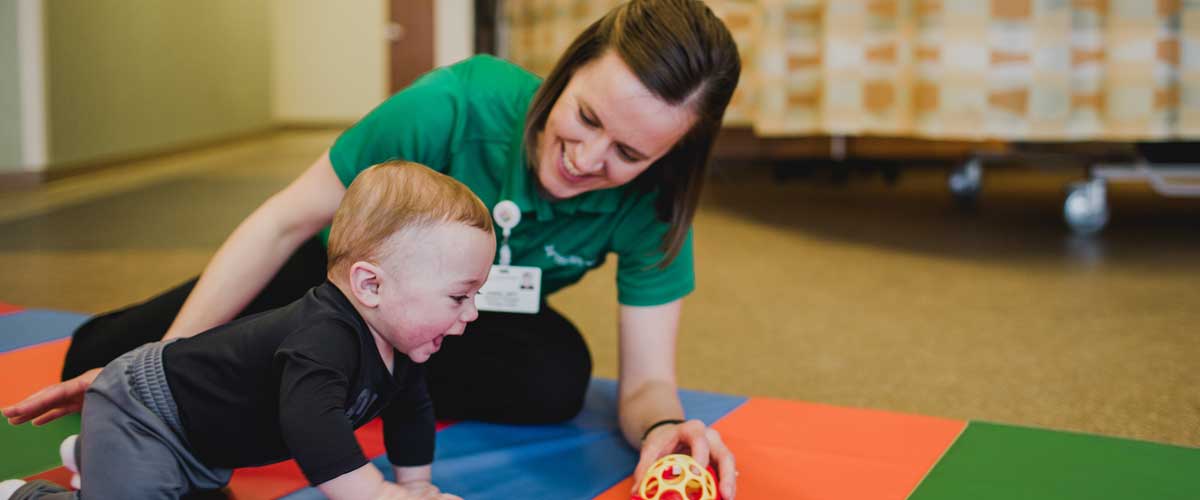How can physical therapy help?
Sensory Processing Disorder can lead to weak core muscles. Core strength is essential for the progression of other development skills as it is the center of control for everything else. Weak core muscles can lead to difficulty sitting up straight in a chair, holding pencils, control scissors, jumping, leads to w sitting, and delayed motor skills development. The key to strengthening these muscles is to have fun through PLAY!
1. Bridging:
Have your child lay on his back with his knees bent and feet flat on the floor. Have them push
hard through their heels to raise their bottom up off the floor. Be sure that they are keeping their head and shoulders on the ground. Can they hold it?
HOW TO CHANGE IT UP:
- Try having your child lift and lower with control (up for a count of 3, down for a count of 3).
- Put a stuffed animal between your child’s knees and have them squeeze while completing the bridging.
- For a BIG challenge, have your child place his feet on a pillow or small ball and try to maintain stability while bridging.
- Zoom some cars underneath — how many cars can you get under the bridge before it falls?
- Find a few small, stuffed animals and walk them under the bridge — don’t squish the bunny!
2. Superman:
Have your little one fly like the superhero and strengthen his back! Have him lay on his stomach on the floor and try to lift his arms off of the floor so that his upper chest comes up too.
HOW TO CHANGE IT UP:
- Can he lift his legs? How about arms and legs at the same time?
- Can he hold a ball between his hands or his feet while lifting up?
- Place a stuffed animal on the child’s back and see if he can complete this exercise with enough control to keep the animal from falling.
- Make it fun by having the child reach up for you to hand him pieces of a puzzle or to place stickers on the wall.
- Make it even more fun by trying it on a swing or a physioball.
3. Knock Me Over:
This can be done with smaller children on your lap, or with bigger kiddos on a large therapy ball or even with them kneeling on both knees. The goal is for them to maintain enough stability through their trunk to stay upright! If you have a small child on your lap, sit on a couch or bed for a soft landing surface. Bounce them up and down a few times (maybe sing “I’m a Little Teapot) and then try to knock them over. The first few times, they will fall for sure, it’s funny! See if you can gradually increase the pressure that it takes to knock them down. And getting up is part of the core workout too! See if you can decrease the amount of assistance it takes to get them back to a sitting position.
HOW TO CHANGE IT UP:
- Have the child in a tall kneeling position on the floor and play catch with balls of varying sizes and weights. The heavier the ball, the bigger the challenge to the core.
- Just sitting and bouncing on the therapy ball is a core workout in itself.
4. Plank:
Have your child lay on his stomach on the floor with his hands flat on the floor at shoulder level and toes on the floor. On the count of 3, have him push up on his hands to straighten his arms and lift his whole body all the way to his toes off of the floor.
HOW TO CHANGE IT UP:
- Have your child hold the plank position on his forearms with his elbows at 90 degrees instead of his hands. If holding his whole body off of the floor is too much, try dropping the knees to the floor for support. While in that position, have him lift an arm straight out in front and hold. How about an opposite arm and leg? Can he hold it long enough for another child to creep underneath or for 3 balls to roll under?
5. Wheelbarrow Walking:
Have your child lay on his stomach on the floor. While you hold his knees (easier) or ankles (bit more of a challenge), have him walk his hands forward 10 steps and backward 10 steps. Can he walk forward to a ball and put it in a basket with one hand? How long can he hold this position without pulling their legs away?
HOW TO CHANGE IT UP:
- Place an object on the child’s back and see if he can get it across the room without it falling off.
- See if he can tap a balloon, keeping it up in the air in front of him as he walks.
- See if he can complete a puzzle from this position, wheelbarrow walking across the room to retrieve the pieces.
- For a BIG challenge, try holding the wheelbarrow position in front of a few steps. See if your child can put their right hand up on the first step and then their left. Can they return their hands to the ground?
6. Core Strengthening For The Babies:
Tummy time! Before they’re born, babies spend 9 months crunched into a very tight space. They need tummy time to stretch out their abdominal muscles and strengthen the muscles of their neck and back.
While the activities described above are perfect for targeting core strengthening specifically, sometimes good old fashioned PLAY activities can have just as much benefit.

